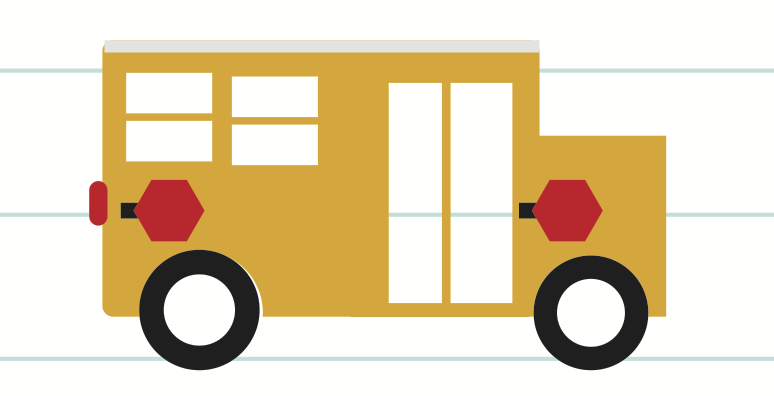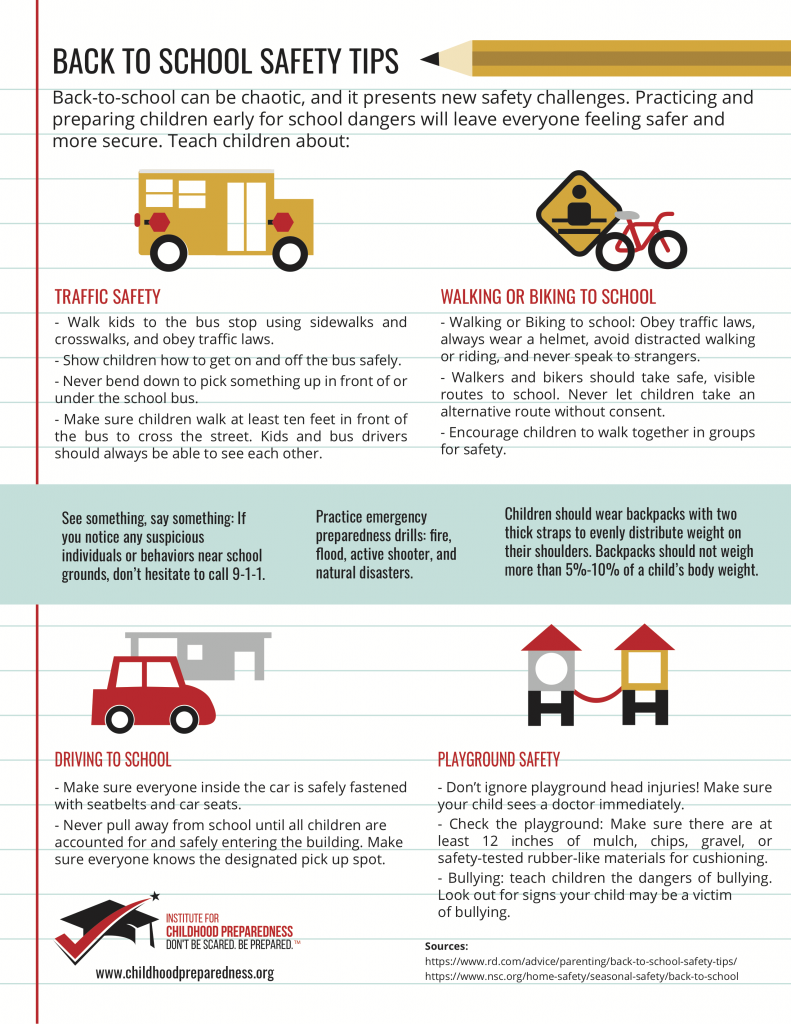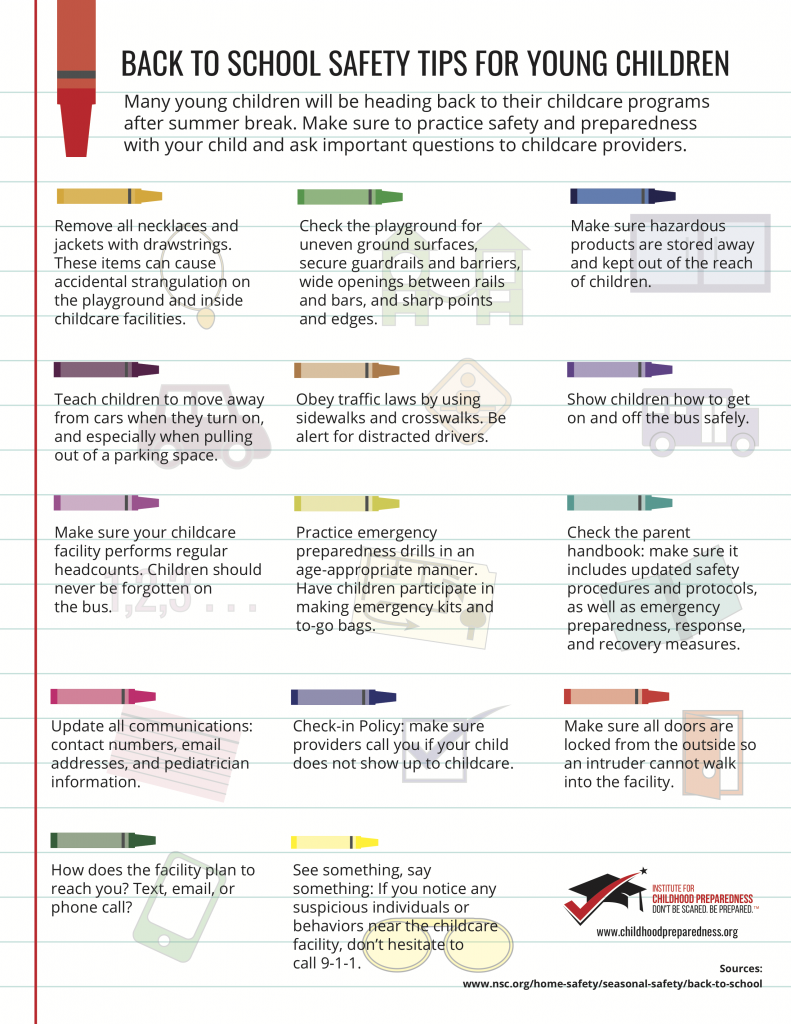September 12, 2019
Back to School Safety Tips by The Institute for Childhood Preparedness

School bus clip art
Source: The Institute for Childhood Preparedness
Photo courtesy of the Institute for Childhood Preparedness
The Institute for Childhood Preparedness shares back to school safety tips for parents and children with us.
A Bit About the Author
The Institute for Childhood Preparedness was founded to empower early childhood professionals with the tools, training, resources, and skills they need to prepare, respond and recover from emergencies and disasters.
The Institute for Childhood Preparedness
Our multidisciplinary team is made up of award-winning first responders and early childhood education specialists with decades of real-world experience. The Institute is committed to providing trainings that are specifically designed for early childhood professionals and those caring for infants, toddlers, and children.
Source: The Institute for Childhood Preparedness
Back-to-school can be a chaotic time for parents and children, and it presents new safety challenges. Practicing and preparing children early for school dangers will leave everyone feeling safer and more secure. Whether your children are entering K-12, or are heading to childcare, practice these safety tips to ensure that everyone has an enjoyable back-to-school experience.
K-12 School Safety Tips
According to Safe Kids Worldwide, “Every day in the U.S. more than 40 kids are hit by a vehicle while walking. That’s more than 15,000 children injured each year.” Children, especially kindergartners, may be unfamiliar with traffic laws. Drivers need to be extra alert during back-to-school, as children may unknowingly dart out into traffic.
Traffic Safety
- Walk kids to the bus stop using sidewalks and crosswalks, and obey traffic laws.
- Show children how to get on and off the bus safely.
- Never bend down to pick something up in front of or under the school bus.
- Make sure children walk at least ten feet in front of the bus to cross the street. Kids and bus drivers should always be able to see each other.
- Teach children to move away from cars when they turn on, and especially when pulling out of a parking space.
Walking or Biking to School
- Obey traffic laws: always wear a helmet, avoid distracted walking or riding, and never speak to strangers.
- Walkers and bikers should take safe, visible routes to school. Never let children take an alternative route without consent.
- Encourage children to walk together in groups for safety.
Driving to School
- Make sure everyone inside the car is safely fastened with seatbelts and car seats.
- Never pull away from school until all children are accounted for and safely entering the building.
- Make sure everyone knows the designated pick up spot.
Playground Safety
- Don’t ignore playground head injuries! Make sure your child sees a doctor immediately.
- Check the playground: make sure there are at least 12 inches of mulch, chips, gravel, or safety-tested rubber-like materials for cushioning.
- Bullying: teach children the dangers of bullying. Look out for signs your child may be a victim of bullying.
Back to school safety tips
Source: The Institute for Childhood Preparedness
Infographic courtesy of Institute for Childhood Preparedness
“Most of the children who lose their lives in bus-related incidents are 4 to 7 years old, and they’re walking,” says The National Safety Council. “They are hit by the bus, or by a motorist illegally passing a stopped bus.”
Drivers, pedestrians, bus riders, and bikers need to pay special attention to crossing guards, stopped school buses, and distracted drivers or walkers. It’s imperative to slow down and pay attention to make sure everyone has a safe commute to and from work, school, or activities.
Back to School Safety Tips for Young Children
For parents sending their little one to childcare for the first time, it can be an overwhelming experience. Babies and toddlers can’t report problems to parents, so it’s up to caregivers to be their child’s eyes and ears. Don’t be afraid to ask providers tough questions and practice safety as well as preparedness procedures with children.
“Nothing is more important than making sure your child is safe and happy,” says Care.com. “If you’re happy, your child will be, too. Even if a facility is licensed, accredited or recommended, keep looking if it doesn’t feel right.”
Indoor and Outdoor Safety
- Remove all necklaces and jackets with drawstrings. These items can cause accidental strangulation on the playground and inside childcare facilities
- Check the playground for uneven ground surfaces, secure guardrails and barriers, wide openings between rails and bars, and sharp points and edges.
- Teach children to move away from cars when they turn on, and especially when pulling out of a parking space.
- Make sure your childcare facility performs regular headcounts. Children should never be forgotten on the bus.
- Make sure hazardous products are stored away and kept out of the reach of children.
- Make sure all doors are locked from the outside so an intruder cannot walk into the facility.
- See something, say something: If you notice any suspicious individuals or behaviors near the childcare facility, don’t hesitate to call 9-1-1.
Emergency Preparedness, Response and Recovery
- Practice emergency preparedness drills in an age-appropriate manner. Have children participate in making emergency kits and to-go bags.
- Check the parent handbook: make sure it includes updated safety procedures and protocols, as well as emergency preparedness, response, and recovery measures.
Communication
- Update all communication information: contact numbers, email addresses, and pediatrician info.
- Check-in Policy: make sure providers call you if your child does not show up to childcare.
- How does the facility plan to reach you? Text, email, or phone call?
Back to School Safety Tips for Young Children
Source: The Institute for Childhood Preparedness
Infographic courtesy of Institute for Childhood Preparedness
Following and practicing back-to-school safety protocols will help ensure that parents and young children have secure and happy childcare experiences.
The Institute for Childhood Preparedness’ award-winning staff has decades of experience in emergency preparedness, response and recovery, and early childhood education. We teach parents, students, teachers, and staff safety techniques to keep everyone safe, secure, and prepared during an emergency or natural disaster.
We can come to your school or community to host an active shooter training, safety summit, or emergency preparedness training. Schedule a training with us today!
Sources
- Things You Need to Know As You Head Back to School by Safe Kids Worldwide
- Slow Down: Back to School Means Sharing the Road by National Safety Council
- 10 Day Care Safety Issues by Care.com
What’s Next?
With the evergrowing popularity and accessibility of the internet, children are being exposed to the world wide age before they even reach school-age.
To learn more about ensuring the safety of your little one online, check out Broadband Search‘s “Ultimate Guide to Keeping Your Kids Safe with Online Controls!“
Interested in having content featured in an upcoming blog post or issue of The Burgundy Zine? Head on over to the submissions page!
For all other inquiries, please fulfill a contact form.



